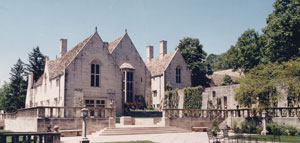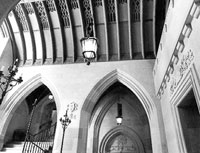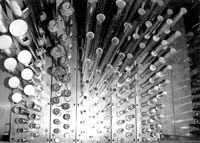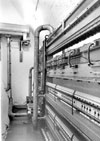The Skinner Organ at Elm Court
August 2004
(From program  #0432)
#0432)
Content provided by Joseph A. Vitacco of JAV recordings.
Information and recordings can be found on the JAV website.
 Images from Elm Court
Images from Elm Court
| |
 |
| |
Elm Court, Butler, PA |
ELM COURT AND IT’S ORGAN
by Joseph F. Dzeda of the A. Thompson-Allen Company
Nestled among the rolling hills of western Pennsylvania, stately Elm Court looks as though it were plucked up from the English Cotswolds and somehow transplanted to the town of Butler. A splendid essay in cut stone, leaded glass and ornamental ironwork, Elm Court is principally the work of Benno Jannsen, a Pittsburgh architect noted for his skill in this style of Tudor-Gothic.
Begun in 1928 and completed in 1931, Elm Court was built for Benjamin D. Philips of the local Philips Gas and Oil Company. In the 1980s, the house was embellished with extensive and architecturally seamless additions, which look as though they have always been there. Today, although the town hurries about its business invisibly just beyond the walls of the estate, a feeling of serenity pervades the house and its flawlessly landscaped grounds. Surely one of America’s greatest private homes, Elm Court survives as a witness to the skill of its builders and the vision of its architects, as well as to those who have loved it and carefully preserved it for more than seventy years.
Upon reading the correspondence between architect and organ-builder, it is apparent that no small amount of planning was involved in providing an instrument, Opus 783, for Elm Court. Whereas Ernest M. Skinner and G. Donald Harrison were responsible for the company’s concert hall and church organs, Arthur Hudson Marks, President of the Skinner Organ Company, took a personal interest in residence organs. When he saw the plans for the location of the pipework at Elm Court, however, he had serious misgivings, for the instrument was not destined for a large ballroom or other traditional space. In a shop letter dated 27 April 1929, he writes:
Please note that this is one of the most unfavorable placed organ chambers we have ever encountered and this job offers a splendid opportunity to fall down hard… It is going to be difficult to get enough volume down from the remote cubby hole under the roof into the great hall far below. Everything must be voiced loud and particular care taken to make the Flute Celeste big enough… All stops should be brought out loud. We can soften any of them easy enough.
 |
|
| The Great Hall at Elm Court |
|
The interior arrangement of Elm Court is a series of intimate, exquisitely appointed rooms connected to each other and to common corridors, with only one two-story space in the entire house, the Main Stair Hall. The corridors and important rooms radiate from the Main Stair Hall, which is faced in stone and surprisingly reverberant. The wisdom of locating an organ in this space is obvious; aside from enfolding the sound of the instrument in the warmth of live acoustics, the organ (right down to the softest murmur from the Flute Celeste) can be heard in the most distant parts of the house in a remarkable way. Mr. Marks need not have feared for the organ’s success, for the installation brings the sound of the organ into the Main Stair Hall with an almost startling immediacy. The entire instrument, except of course the console which is placed in the adjoining Great Hall, speaks from a seven-by-twenty-eight-foot chamber, ten feet high, lined with glass-hard Keenes Cement laid over a one inch-thick layer of cork for temperature isolation. The pipework and chassis stand on a shelf tucked beneath the apex of the roof peak above; the organ really speaks into the small end of a short and very effective horn-shaped tone chute. The outlet of this horn is poised immediately above the open-tracery panels at the peak of the wooden ceiling in the Main Stair Hall.
| |
 |
| |
Pipes of the Skinner organ |
Perhaps Mr. Marks’concern for tonal egress prompted some changes, for a Skinner Organ Company drawing dated 14 May 1929, shows a redesigned ceiling, with a larger area of opening than initially planned. As the stoplist suggests, the organ consists of two side-by-side expressive divisions, all stops independently playable from either manual. With this arrangement, any stop in the organ may be played with or against any other stop, offering enormous flexibility for the organist. Many of the famous Skinner voices are to be found at Elm Court, including the English Horn, French Horn, Clarinet, Harp, and three hauntingly beautiful celeste stops. And while the Skinner Organ Company’s motto for their residence organs, Multum in Parvo (“much from little”) might seem “a little much,” the idea is a solid one, made possible through the clever use of pneumatic duplexing technology to control the valves under the pipes. Skinner organ actions are famous for their great speed and uniformity and are the result of electrically-triggered pneumatic logic. The speed, reliability, durability and renewability of this mechanism, as much as the outstanding musical qualities of the organ, virtually dictated the faithful restoration of Opus 783, especially for a client who is a connoisseur of treasures from both the distant and recent past.
In 1990 the instrument was dismantled and removed from Elm Court, excepting the carved casework of the console, the Spencer Turbine blower, and the main chest shells in the organ chamber. All of the organ’s components were cleaned and renewed, from pipes to windchests and other mechanism. Perishable materials such as leather and felt were replaced with new materials of identical quality, painstakingly installed according to the standards of the builder of the organ. After reassembly a considerable amount of time was spent regulating the speed of the action and the speech of the pipes for uniformity. The restorers made no attempt to change the musical or technological qualities of the instrument, this being their standard practice for many years.
 |
|
| The self playing mechanism of the organ |
|
Perhaps the most amazing feature of the organ is its roll-playing capability. The perforations in the moving paper roll are read pneumatically in the console spoolbox, and converted into electrical impulses which then are sent to the electro-pneumatic computer in the relay room next to the organ chamber. Here these signals, ingeniously multiplexed to conserve paper width, are converted to standard organ control language, recreating the remarkable music heard in this recording. Even for those who are jaded by twenty-first-century technology, it is an impressive experience to stand in the relay room while the machinery decodes the rolls and plays the organ. Few who hear the organ negotiate a complicated overture can imagine how furiously the computer is going about its work. With scores of electro-pneumatic switches, relays and valves moving with split-second timing, the mechanical commotion in the relay room almost eclipses the musical excitement coming from the pipework of the organ.

![]() #0432)
#0432)





